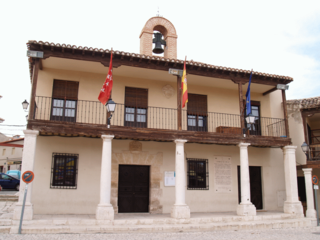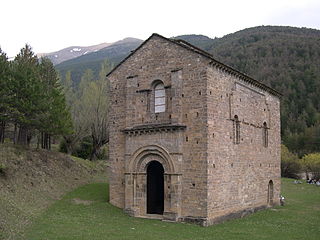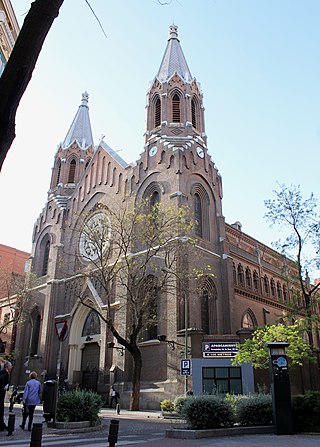
The Instituto Nacional de Antropología e Historia is a Mexican federal government bureau established in 1939 to guarantee the research, preservation, protection, and promotion of the prehistoric, archaeological, anthropological, historical, and paleontological heritage of Mexico. Its creation has played a key role in preserving the Mexican cultural heritage. Its current national headquarters are housed in the Palace of the Marqués del Apartado.

Baelo Claudia was an ancient Roman town of Hispania, located 22 kilometres (14 mi) outside of Tarifa, near the village of Bolonia, in southern Spain. Lying on the shores of the Strait of Gibraltar, the town was originally a fishing village and trade link when it was settled some 2,000 years ago. Although prosperous at the time of Emperor Claudius, it went into a decline hastened by earthquakes and was abandoned by the 6th century.

Pedrosa de la Vega is a municipality located in the province of Palencia, Castile and León, Spain. According to the 2004 census (INE), the municipality had a population of 366 inhabitants.

In Spain, the legal designation Conjunto histórico is part of the national system of heritage listing. It is applied to buildings in a given locality. It is typically used to protect complete villages, such as Peñaranda de Duero, or historic quarters of towns such as Avilés.

Colmenar de Oreja is a town and municipality of the Las Vegas comarca, in the Community of Madrid, Spain. It was subject to a seven-month siege in 1139.

The Treasure of Villena is one of the greatest hoard finds of gold of the European Bronze Age. It comprises 59 objects made of gold, silver, iron and amber with a total weight of almost 10 kilograms, 9 of them of 23.5 karat gold. This makes it the most important find of prehistoric gold in the Iberian Peninsula and second in Europe, just behind that from the Royal Graves in Mycenae, Greece.

A Bien de Interés Cultural is a category of the heritage register in Spain. The term is also used in Venezuela and other Spanish-speaking countries.
Bien de Interés Cultural is a category in the Spanish heritage register. It covers various types of cultural heritage, which fall into sub-categories such as monuments, historic gardens, etc.

A jardín histórico is a Spanish historic garden. In Spain Jardín histórico is a heritage listing which protects historic gardens.. The Spanish listing was established in 1983, replacing a former heritage category Jardín artístico. It is currently regulated by the Ministry of Education, Culture and Sport.
Patrimonio histórico español is a term for Spain's heritage, including National Heritage Sites. The Ministry of Culture has a department, the Subdirección General de Protección del Patrimonio Histórico which maintains a heritage register.
The cultural monuments of the Czech Republic are protected properties designated by the Ministry of Culture of the Czech Republic. Cultural monuments that constitute the most important part of the Czech cultural heritage may be declared national cultural monuments by a regulation of the Government of the Czech Republic. Government may also proclaim a territory, whose character and environment is determined by a group of immovable cultural monuments or archaeological finds, as a whole, as a monument reservation. Ministry of Culture may proclaim a territory of a settlement with a smaller number of cultural monuments, historical environment or part of a landscape area that display significant cultural values as a monument zone.

Castrojeriz or Castrogeriz is a locality and municipality located in the province of Burgos, in the autonomous community of Castile and León (Spain), the comarca of Odra-Pisuerga, the judicial district of Burgos, head of the town council of the same name and former head of the Castrojeriz judicial district.

The Church of La Milagrosa, formerly Church of San Vicente de Paul, is a Roman Catholic church in Madrid, Spain. With an area of 900 square metres (9,700 sq ft), it is situated on Calle García de Paredes, west of the InterContinental Madrid. The church was built between 1900 and 1904 under the architects Juan Bautista Lázaro de Diego and Narciso Clavería y de Palacios. The architecture is eclectic, exhibiting Neo-Mudéjar features on the exterior and mainly Neo-Gothic features in the interior.

The archaeological site Peñas de Cabrera, containing numerous rock shelters, is located in the municipality of Casabermeja (Spain). The entire surrounding area of Las Peñas de Cabrera, rife with natural minerals, rocks and fossils, is named after one of its districts of the same name. The entire complex of mountains and valleys consists of many shelters revealing rock art of paintings and engravings.
Bartolomé Ruiz González is a Spanish archaeologist who has been involved in cultural management in Andalucia since the late 1970s. He currently runs the Archaeological Ensemble of the Antequera Dolmens and is the director of the Royal Academy of Fine Arts of Antequera.
The Antequera Dolmens Site is a cultural heritage ensemble comprising three cultural monuments and 2 natural mountain features in and near the city of Antequera in Andalusia, Spain. The cultural institution responsible for its protection is the CADA. It was declared a World Heritage Site in 2016.

The Hipódromo de la Zarzuela is a race course on the outskirts of Madrid, Spain. It was designed in the 1930s. The architecture is in a modernist style which has been described as racionalismo madrileño.












